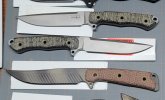Ugh... Making me drool!! I am still searching for a BG Urban Grudge and just missed the one on the exchange because I was having dinner with my kids!
But I would say the above are great examples of "Swedges" and not "False Edges"... at least in my mind.
IN MY MIND: a false edge can either be (referring to my above potential definitions):
A) something that LOOKS like a dagger, Primary grinds of a dagger, but has only one truly sharpened edge, and an unsharpened "spine".
or
B) Imagine a Busse P&L, or other model variant with a harpoon tip, where the length of the harpoon tip is sharpened, but not the rest of the spine. So the main Edge side is sharpened 100% of the intended length of the blade (minus coil and ricasso), but the "spine-side" is partially sharpened, but not the whole length.
Then again, what is a "false edge"? By what definition?

